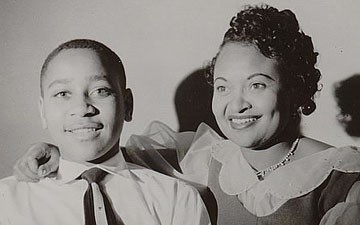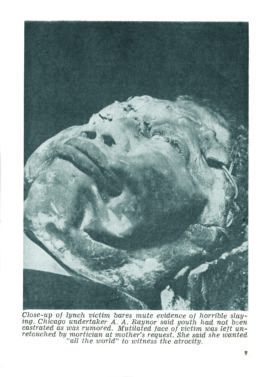[ad_1]
August 28, 1955, is the date of the murder of 14-year-old Emmett Till, an African-American teen who was visiting his family in Money, Mississippi, for the summer.

Emmett Till and his mother, Mamie Elizabeth Till-Mobley, in 1955.
Before he was killed, Till was kidnapped and tortured for allegedly flirting with Carolyn Bryant, a White woman and cashier at Bryant’s Grocery Store. Although some racism toward Blacks existed up North, it was nothing like what the Chicago native would experience in the rural South. His mother, Mamie Elizabeth Till-Mobley, warned him to be more mindful of his behavior. “She told him ‘to be very careful . . . to humble himself to the extent of getting down on his knees,’” according to Time.
On Aug. 24, Till was with his cousins outside of the grocery store. He told them that back home, on the South Side of Chicago, he had a White girlfriend. The boys did not believe him, and in adolescent fun dared him to ask Bryant on a date. According to the History Channel website, Till went into the store, purchased some candy and was accused of saying, “Bye, baby,” to Bryant. She was the only person in the store at the time, and later claimed that Till grabbed and whistled at her before exiting.
Till’s cousin, Maurie Wright, told United Press International, “Emmett went into the store and asked for some bubble and left after telling the woman ‘goodbye.’ Outside, Emmett gave a ‘wolf call.’ I told Emmett to be careful of what he said in the store.”
The accuser’s husband, Roy Bryant, returned to town and was enraged that a Black boy had spoken to his wife in such a way. Bryant and his half brother, J.W. Milan, searched for Till four days after the store incident. They went to the home of his great-uncle, Moses Wright, and against his pleas forced his teenage nephew into the car.

Emmett Till’s open casket Sept. 15, 1955, issue of JET Magazine Credit: Johnson Publication/EBONY Magazine
After having Till in their custody, they beat him senseless. Then they reportedly made him carry a 75-pound cotton-gin fan to the bank of the Tallahatchie River, where the two men gouged out his eye, shot him in the head and tied him by the neck to the apparatus using barbed wire before throwing him into the water.
Till’s corpse was discovered three days later. His body was so mutilated that Wright was unable to recognize his nephew. He identified the corpse by an initialed ring. After hearing the news of her son’s murder, instead of letting authorities quickly and silently get rid of the body, Till-Mobley asked for him to be sent back to Chicago.
When she arrived at the train station to pick up her only son’s remains, the woman was outraged to see his ear severed, his teeth missing and his eye hanging out of the socket. In an act that would change the world, Till-Mobley requested an open casket at his funeral and instructed the mortician not to touch up the boy’s face.
Fifty thousand people are reported to have gone to Till’s funeral. With permission from his mother, JET magazine ran photos of his body in the coffin in the article, “Nation Horrified by Murder of Kidnap Chicago Youth.” Till-Mobley wanted people across America to see what two White men in Mississippi did to her son.
Nearly two weeks after the funeral, Milam and Roy Bryant faced trial in Sumner, Mississippi. Wright identified the defendants as Till’s killers in the segregated courthouse. An all-White jury, however, found them not guilty after less than an hour of deliberation on Sept. 23.
The Emmett Till murder trial was the catalyst for the Civil Rights Movement. In December of that year, the Montgomery bus boycott began in Alabama.
In January 1956, Milam and Bryant confessed during an interview with Look magazine to killing Till. According to the article, “The Shocking Story of Approved Killing in Mississippi,” the pair had planned to only beat the teen but killed him when he showed no fear. The U.S. Justice Department reopened the case in 2004, and Till’s body was exhumed by the FBI for an autopsy in 2005. There were no indictments, and no one has been convicted of his murder.
Till became an icon in the long-established persecution of African-Americans in the United States. It is one of the first publicized incidents that displayed the demonization and criminalization of Black boys. Two glaring examples are the 2012 death of Jordan Davis, 17, and the 2014 killing of Tamir Rice, 12.
Davis was fatally shot while sitting in a car at a gas station in Jacksonville, Florida, by Michael David Dunn, 47, after a dispute over loud music. Rice was shot within seconds of police arriving at a Cleveland playground after a resident reported that Rice had a gun, which turned out to be a toy.

Tamir Rice and Jordan Davis
Till’s murder is often referenced in pop culture from works of literature including Harper Lee’s To Kill a Mockingbird and songs such as “My Name is Emmett Till” by Emmylou Harris. In 2016, a White artist, Dana Schutz, painted Open Casket, an abstract work based on photographs of Till in his coffin. The painting drew protests as “an injustice to the black community.”
In 2017, Timothy B. Tyson, a professor at Duke University, published the book, The Blood of Emmett Till, in which Till’s accuser, now known as Carolyn Donham, revealed that she lied in her testimony about the boy grabbing her waist or making lewd comments to her.
Following Donham’s recanted story, Till’s cousin Wheller Parker, 77, told The New York Times, “I was hoping that one day she would admit it, so it matters to me that she did, and it gives me some satisfaction. It’s important to people understanding how the word of a White person against a Black person was law, and a lot of Black people lost their lives because of it. It really speaks to history; it shows what Black people went through in those days.”
[ad_2]
Source link

